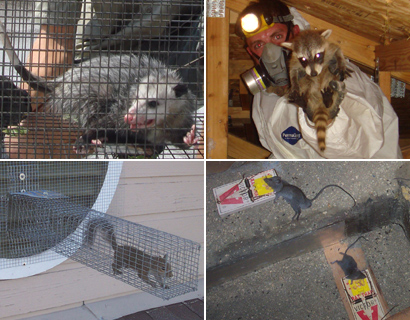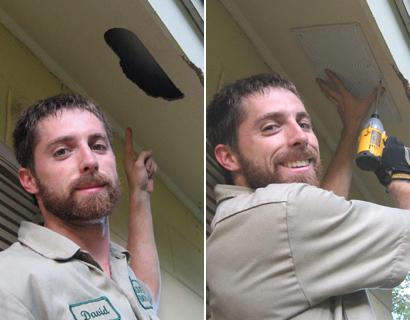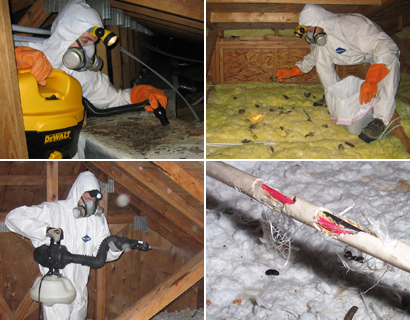- How We Solve California Wildlife Problems
How We Solve Ontario Wildlife Problems
INSPECTION: Once on site, we will perform a full inspection of your home and property. This allows us to use the correct strategy and traps. If the animals are in an attic, a full building inspection is crucial, including the following:
- All ground-level areas, such as piper or A/C line entry & exit areas, A/C chase bottoms, ground-level vents, etc.
- All mid-level areas, such as dryer vents, siding gaps, first floor eaves or dormers, etc.
- We inspect the entire roof, including all plumbing stacks, ridge caps, vents, and other potential gaps or holes.
- We also inspect inside your attic, to identify animals and damage they have caused.
- If the animals are outside, we notice many subtle clues that will assist us in a successful strategy.
TRAPPING, EXCLUSION, REMOVAL: Once we understand what animal species we are dealing with, and the problem, we use the most effective means of removing the animals. We use dozens of different types of traps.
- Trapping - If trapping the animal(s) in live cage traps, trap type, set, and location are crucial to success.
- Exclusion - Oftentimes, we are able to simply set one-way doors or other exclusion devices that allow the animals inside a building to safely exit, but never get back inside.
- Removal By Hand - Sometimes we actually remove animals by hand, or with special tools like snare poles.
- The Law - In all cases, we obey state and local laws regarding wildlife, but aim to take the most humane approach.
ENTRY HOLE REPAIRS: Repairs are a crucial step in the wildlife removal process. In many cases, such as bat or rodent control, the job cannot be performed without detailed repairs, and in all cases, sealing the entry holes shut ensures that no future wildlife will ever enter your home.
- 100% of the entry holes must be found, and sealed shut, or the job is not complete.
- Our repairs are professional contractor grade, look good, and when applicable we use steel, which rodents such as rats or squirrels are unable to chew through.
- We give a written guarantee on our repairs against any future animal entry.
ATTIC DECONTAMINATION SERVICES: It may be desirable to clean your attic after we've removed the animals. They can leave behind large amounts of droppings, urine, hair, oils, food, nesting material, and so on. These remnants can attract insects like cockroaches, and the scent left behind can encourage new animals to chew their way into your house. You might experience odor problems from the waste. It's possible that mold will grow on waste areas.
- We remove or vacuum all droppings, or remove all the soiled insulation.
- We fog the attic with a special enzyme-based cleaner that destroys any organic matter and deodorizes the space.
- We repair damage, such as ductwork, electrical wires, pipes, insulation, and more.
With over ten years of experience in handling wildlife control and removal problems, why wouldn't you want to put your faith in us - a family-run business who promises to practice only safe and humane wildlife removal. We treat both our customers and the animals we capture in the same way we would want to be treated - with courtesy and respect. That's why we don't work with poisons. We use exclusion devices and live cage traps to evict those wild critters from your home, sealing up doorways as we go to make sure they can't come back. Where necessary, larger animals such as raccoons will be relocated many miles away from your property - in some cases ten to fifteen miles and more - and we cover both residential and commercial buildings too. We cover commercial liability insurance, and we're all not only fully trained and educated, but fully licensed and insured too. Our phones are answered 24 hours a day, 7 days a week, and that's the schedule our technicians work too also - locally to you. If you have a wild animal emergency, we're the right people for the job. You should give us a call for your free quote today.
We service Kern County, Inyo County, Orange County, Clark County, Mohave County, La Praz County, Riverside County, and more. We also service Fontana, Rancho Cucamonga, San Bernardino, Victorville, Rialto, Hesperia, Chino, Chino Hills, Upland, Apple Valley, Redlands, Highland, Colton, Yucaipa, Montclair, Adelanto, Twentynine Palms, Loma Linda, Barstow, Yucca Valley, Grand Terrance, Big Bear Lake, Neeldes, Baker, Lake Arrowhead, Oak Hills, Lenwood, Phelan, Big River, Lucerne Valley, Pinon Hills, Bloomington, Lytle Creek, Running Springs, Bluewater, Mentone, San Antonio Heights, Crestline, Morongo Valley, and more. To learn more about our services, visit the Ontario wildlife control home page.
This month's wildlife how-to article: How to identify fox tracks
There is something fascinating about the fox. They are sneaky, quiet, and mysterious. These little creatures can be found all around the world. In fact, the only place they cannot be found is Antarctica. While they are mostly solitary creatures, they can and do thrive in towns, suburbs, the country and even in big cities.
Foxes are in the same family as wolves and dogs. In most cases, they are only 7-15 pounds. They are most noted for their red fur, white chest, and red bushy tail. However, there are many different colors and breeds. Unlike wolves and even dogs, foxes prefer to be alone. While they do like to be alone, foxes make excellent parents. Some litters can have only one pup, but others can have as many as eleven.
They are friendly and somewhat playful. They are curious creatures and can often be found interacting with domestic dogs and even cats. On occasion, they will also interact with humans. While foxes resemble dogs, they have quite a bit in common with cats. Their eyes have vertical pupils that help them to see better at night. In fact, that's not all they have in common. Their whiskers play a significant role in everyday life. They are sensitive and help them feel the air around them. They are also very light on their feet. Like cats, they walk on their toes and are able to retract their claws to allow for better climbing.
It is because of this that their footprints are similar to a cat's and yet still resemble a dog's. Like their canine relatives, their prints tend to be oval. In some cases, their claws may be seen in front of each toe, but that depends on the type of material they are walking through.
Sometimes, the details of a fox print may be hard to determine. This is because for some foxes—mainly the red fox—have tiny toe pads, and their feet are covered with thick fur. On average, fox footprints measure 1 ¾ to 2 ½ inches long while ranging from 1 ½ inches to two inches in width.
Because they are close to their domestic family of dogs and their wild family of coyotes, fox prints are often mistaken for something else. They are easy to mistake because they are almost identical to those of a coyote and many different breeds of dogs.
If you suspect that there is a fox lingering around your home, call your wildlife conservation department. They typically pose no threat to humans or other pets; however, they can cause some severe damage to a chicken coop. Someone will come to your home, trap and then safely relocate the animal.





